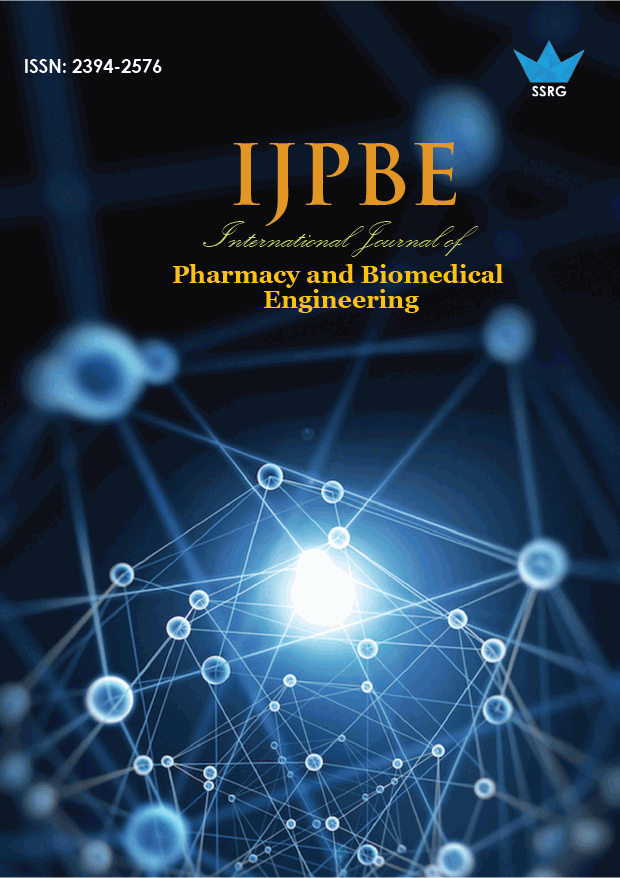Non-Invasive Blood Glucose Monitoring System Using Near-Infrared Spectroscopy: A Prototype Design

| International Journal of Pharmacy and Biomedical Engineering |
| © 2025 by SSRG - IJPBE Journal |
| Volume 12 Issue 2 |
| Year of Publication : 2025 |
| Authors : Akhila Polisetti |
How to Cite?
Akhila Polisetti, "Non-Invasive Blood Glucose Monitoring System Using Near-Infrared Spectroscopy: A Prototype Design," SSRG International Journal of Pharmacy and Biomedical Engineering, vol. 12, no. 2, pp. 1-7, 2025. Crossref, https://doi.org/10.14445/23942576/IJPBE-V12I2P101
Abstract:
This research study focuses on designing a non-invasive prototype for monitoring blood glucose levels using near-infrared spectroscopy. Diabetes is one of the most common chronic diseases globally, and the invasive methods do not always offer accurate readings as they are affected by several factors, such as the presence of dirt on the skin, not applying enough blood to the strip, and more. Hence, discovering non-invasive methods is essential for painless and accurate detection of blood glucose concentrations. The rationale for this new research lies in the development of novel methods to monitor blood glucose levels. The research methods involve ideating and designing a prototype of the device, involving the required hardware components as well as the key software filters needed for the device to function effectively. The study’s significant findings demonstrate that it is possible to detect blood glucose levels using NIR light and analyze them using a photodiode and a microcontroller, making future enhancements in this field possible. The significance of this study lies in its contribution to improving the current methods for monitoring glucose levels by making sure the newer method is painless, reliable and not impacted by external factors.
Keywords:
Blood glucose levels, Light intensity, Near-Infrared Spectroscopy, NIR wavelength, Tissue.
References:
[1] What Is Diabetes?, National Institute of Diabetes and Digestive and Kidney Diseases. [Online]. Available: https://www.niddk.nih.gov/health-information/diabetes/overview/what-is-diabetes
[2] Cleveland Clinic, Diabetes. [Online]. Available: https://my.clevelandclinic.org/health/diseases/7104-diabetes
[3] World Health Organization, Diabetes. [Online]. Available: https://www.who.int/news-room/fact-sheets/detail/diabetes#:~:text=In%202022%2C%2014%25%20of%20adults,Symptoms%20of%20diabetes%20include
[4] Leann Olansky, and Laurence Kennedy, “Finger-Stick Glucose Monitoring: Issues of Accuracy and Specificity,” Diabetes Care, vol. 33, no. 4, pp. 948-949, 2010.
[CrossRef] [Google Scholar] [Publisher Link]
[5] Mayo Clinic, Blood Glucose Monitors: What Factors Affect Accuracy? [Online]. Available: https://www.mayoclinic.org/diseases-conditions/diabetes/expert-answers/blood-glucose-monitors/faq-20057902
[6] Anmole S. Bolla, and Ronny Priefer, “Blood Glucose Monitoring- an Overview of Current and Future Non-Invasive Devices,” Diabetes & Metabolic Syndrome: Clinical Research & Reviews, vol. 14, no. 5, pp. 739-751, 2020.
[CrossRef] [Google Scholar] [Publisher Link]
[7] Jyoti Yadav et al., “Prospects and Limitations of Non-Invasive Blood Glucose Monitoring Using Near-Infrared Spectroscopy,” Biomedical Signal Processing and Control, vol. 18, pp. 214-227, 2015.
[CrossRef] [Google Scholar] [Publisher Link]
[8] Malvern Panalytical, Near Infrared Spectroscopy – Overview. [Online]. Available: https://www.malvernpanalytical.com/en/products/technology/spectroscopy/near-infrared-spectroscopy#:~:text=NIR%20spectroscopy%20is%20a%20method,properties%20without%20altering%20the%20sample
[9] William Oñate et al., “NIR-Based Electronic Platform for Glucose Monitoring for the Prevention and Control of Diabetes Mellitus,” Sensors, vol. 24, no. 13, 2024.
[CrossRef] [Google Scholar] [Publisher Link]
[10] Biagio Todaro et al., “Is Raman the Best Strategy Towards the Development of Non-invasive Continuous Glucose Monitoring Devices for Diabetes Management?,” Frontiers in Chemistry, vol. 10, 2022.
[CrossRef] [Google Scholar] [Publisher Link]
[11] tec5USA, What is NIR Spectroscopy?. [Online]. Available: https://www.tec5usa.com/spectroscopy/
[12] NIRLAB, How Does Near-Infrared Spectroscopy Work? [Online]. Available: https://www.nirlab.com/blog/nir-spectroscopy-nutshell/
[13] Guangcun Chen et al., “Advanced Near-Infrared Light for Monitoring and Modulating the Spatiotemporal Dynamics of Cell Functions in Living Systems,” Advanced Science, vol. 7, 2020.
[CrossRef] [Google Scholar] [Publisher Link]
[14] Oxford Instruments, Measuring Glucose Concentration NIR Absorption Spectroscopy. [Online]. Available: https://andor.oxinst.com/learning/view/article/spectral-response-of-glucose
[15] Aminah Hina, and Wala Saadeh, “Noninvasive Blood Glucose Monitoring Systems Using Near-Infrared Technology-A Review,” Sensors, vol. 22, no. 13, 2022.
[CrossRef] [Google Scholar] [Publisher Link]
[16] Alexandre Mallet et al., “Relating Near-Infrared Light Path-Length Modifications to the Water Content of Scattering Media in Near-Infrared Spectroscopy: Toward a New Bouguer-Beer-Lambert Law,” Analytical Chemistry, vol. 93, no. 17, pp. 6817-6823, 2021.
[CrossRef] [Google Scholar] [Publisher Link]
[17] tec5USA, What is Beer Lambert (Beer’s) Law & How Does it Enable Spectroscopy?. [Online]. Available: https://www.tec5usa.com/beer-lambert-law/
[18] ScienceDirect, Beer-Lambert Law. [Online]. Available: https://www.sciencedirect.com/topics/engineering/beer-lambert-law
[19] Paul Murray Koster, “Near Infrared Light Penetration in Human Tissue: An Analysis of Tissue Structure and Heterogeneities,” Dissertations, Theses, and Professional Projects, 2009.
[Publisher Link]
[20] Theodore A. Henderson, and Larry D. Morries, “Near-Infrared Photonic Energy Penetration: Can Infrared Phototherapy Effectively Reach the Human Brain?,” Neuropsychiatric Disease and Treatment, vol. 11, pp. 2191-2208, 2015.
[Google Scholar] [Publisher Link]
[21] Qing Ge et al., “Evaluation and Validation on Sensitivity of Near-Infrared Diffuse Reflectance in Non-Invasive Human Blood Glucose Measurement,” Sensors, vol. 24, no. 18, 2024.
[CrossRef] [Google Scholar] [Publisher Link]
[22] Tissue Interaction. [Online]. Available: https://www.sciencedirect.com/topics/biochemistry-genetics-and-molecular-biology/tissue-interaction
[23] Daria Di Filippo et al., “Non-Invasive Glucose Sensing Technologies and Products: A Comprehensive Review for Researchers and Clinicians,” Sensors, vol. 23, no. 22, 2023.
[CrossRef] [Google Scholar] [Publisher Link]
[24] Willem Windig, Jeremy Shaver, and Rasmus Bro, “Loopy MSC: A Simple Way to Improve Multiplicative Scatter Correction,” Applied Spectroscopy, vol. 62, no. 10, pp. 1153-1159, 2008.
[CrossRef] [Google Scholar] [Publisher Link]
[25] Multiplicative Scatter Correction (MSC). [Online]. Available: https://guifh.github.io/RNIR/MSC.html
[26] Two Scatter Correction Techniques for NIR Spectroscopy in Python, NIRPY Research, 2018. [Online]. Available: https://nirpyresearch.com/two-scatter-correction-techniques-nir-spectroscopy-python/#:~:text=Different%20wavelengths%20of%20the%20incident,for%20the%20quantity%20of%20interest

 10.14445/23942576/IJPBE-V12I2P101
10.14445/23942576/IJPBE-V12I2P101